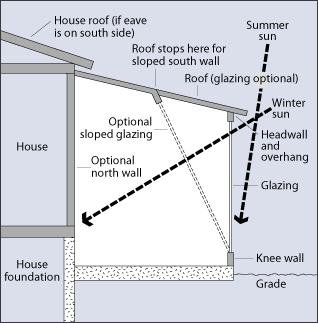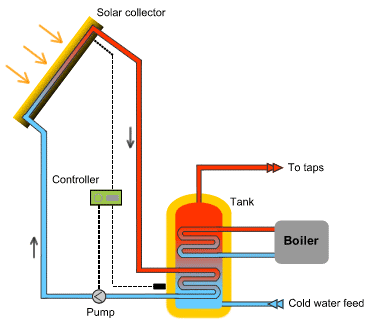For as long as engineers have designed buildings, they have taken advantage of the sun to ensure the comfort of the people inside. Through constant refinement, many sophisticated techniques have emerged that can greatly reduce the energy demands of buildings. Solar hot water is one such technique that is enjoying a strong resurgence in popularity. We will deal with that separately below.

A simple technique involves the placement of windows. The south side of a building always receives the most sunlight. Therefore, buildings designed for passive solar heating usually have large, south-facing windows. Materials that absorb and store the sun's heat can be built into the sunlit floors and walls. The floors and walls will then heat up during the day and slowly release heat at night, when the heat is needed most. This passive solar design feature is called direct gain .
Other passive solar heating design features include sunspaces and trombe walls. A sunspace (which is much like a greenhouse) is built on the south side of a building. As sunlight passes through glass or other glazing, it warms the sunspace. Proper ventilation allows the heat to circulate into the building. On the other hand, a trombe wall is a very thick, south-facing wall, which is painted black and made of a material that absorbs a lot of heat. A pane of glass or plastic glazing, installed a few inches in front of the wall, helps hold in the heat. The wall heats up slowly during the day. Then as it cools gradually during the night, it gives off its heat inside the building.
More sophisticated technologies include ventilation air preheating, solar process heating, and solar cooling. Many large buildings need ventilated air to maintain indoor air quality. In cold climates, heating this air can use large amounts of energy. A solar ventilation system can preheat the air, saving both energy and money. This type of system typically uses a transpired collector , which consists of a thin, black metal panel mounted on a south-facing wall to absorb the sun's heat. Air passes through the many small holes in the panel. A space behind the perforated wall allows the air streams from the holes to mix together. The heated air is then sucked out from the top of the space into the ventilation system.
Solar process heating systems are designed to provide large quantities of hot water or space heating for nonresidential buildings. A typical system includes solar collectors that work along with a pump, a heat exchanger, and/or one or more large storage tanks. The two main types of solar collectors used - an evacuated-tube collector and a parabolic-trough collector - can operate at high temperatures with high efficiency. An evacuated-tube collector is a shallow box full of many glass, double-walled tubes and reflectors to heat the fluid inside the tubes. A vacuum between the two walls insulates the inner tube, holding in the heat. Parabolic troughs are long, rectangular, curved (U-shaped) mirrors tilted to focus sunlight on a tube, which runs down the center of the trough. This heats the fluid within the tube.
The heat from a solar collector can also be used to cool a building by using the solar heat as an energy source.

Solar Hot Water
The shallow water of a lake is usually warmer than the deep water. That's because the sunlight can heat the lake bottom in the shallow areas, which in turn, heats the water. The sun can be used in basically the same way to heat water used in buildings and swimming pools.
In the 1890s solar water heaters were being used all over the United States. They proved to be a big improvement over wood and coal-burning stoves. Artificial gas made from coal was available too to heat water, but it cost 10 times the price we pay for natural gas today, and electricity was not widely available. In 1897, 30 percent of the homes in Pasadena were equipped with solar water heaters. As mechanical improvements were made, solar systems were used in Arizona, Florida and many other sunny parts of the United States.
By 1920, ten of thousands of solar water heaters had been sold. By then, however, large deposits of oil and natural gas were discovered in the western United States. As these low cost fuels became available, solar water systems began to be replaced with heaters burning fossil fuels. Now with the rising costs of fossil fuels, solar hot water heating is making a comeback.
Most solar water heating systems for buildings have two main parts: a solar collector and a storage tank. The most common collector is called a flat-plate collector. Mounted on the roof, it consists of a thin, flat, rectangular box with a transparent cover that faces the sun. Small tubes run through the box and carry the fluid – either water or other fluid, such as an antifreeze solution – to be heated. The tubes are attached to an absorber plate, which is painted black to absorb the heat. As heat builds up in the collector, it heats the fluid passing through the tubes.
The storage tank then holds the hot liquid. It can be just a modified water heater, but it is usually larger and very well-insulated. Systems that use fluids other than water usually heat the water by passing it through a coil of tubing in the tank, which is full of hot fluid.
Solar water heating systems can be either active or passive, but the most common are active systems. Active systems rely on pumps to move the liquid between the collector and the storage tank, while passive systems rely on gravity and the tendency for water to naturally circulate as it is heated.
Swimming pool systems are simpler. The pool's filter pump is used to pump the water through a solar collector, which is usually made of black plastic or rubber. And of course, the pool stores the hot water.
Solar Energy Engineering |
Why Solar Energy? |
Photovoltaics |
Solar Electricity